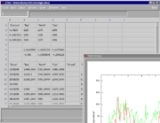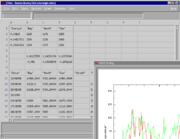
GNU Oleo
Encyclopedia

Free software
Free software, software libre or libre software is software that can be used, studied, and modified without restriction, and which can be copied and redistributed in modified or unmodified form either without restriction, or with restrictions that only ensure that further recipients can also do...
spreadsheet
Spreadsheet
A spreadsheet is a computer application that simulates a paper accounting worksheet. It displays multiple cells usually in a two-dimensional matrix or grid consisting of rows and columns. Each cell contains alphanumeric text, numeric values or formulas...
originally designed as a text-based spreadsheet using the curses
Curses (programming library)
curses is a terminal control library for Unix-like systems, enabling the construction of text user interface applications.The name is a pun on the term “cursor optimization”. It is a library of functions that manage an application's display on character-cell terminals .- Overview :The curses API...
library. The last development version of Oleo, 1.99.16, was released in 2001.
The project was started in 1992 by Tom Lord, and became part of the GNU initiative
GNU Project
The GNU Project is a free software, mass collaboration project, announced on September 27, 1983, by Richard Stallman at MIT. It initiated GNU operating system development in January, 1984...
around 1994. At the time, the only open source alternative was the older text-based sc, both products having similar functionality to early versions of Lotus 123 or Microsoft Excel
Microsoft Excel
Microsoft Excel is a proprietary commercial spreadsheet application written and distributed by Microsoft for Microsoft Windows and Mac OS X. It features calculation, graphing tools, pivot tables, and a macro programming language called Visual Basic for Applications...
. Oleo's key bindings however were inspired from the Unix world, and similar to those used by the emacs
Emacs
Emacs is a class of text editors, usually characterized by their extensibility. GNU Emacs has over 1,000 commands. It also allows the user to combine these commands into macros to automate work.Development began in the mid-1970s and continues actively...
editor, which frustrated novice users familiar with the MS DOS counterparts. Oleo and sc were the first Unix
Unix
Unix is a multitasking, multi-user computer operating system originally developed in 1969 by a group of AT&T employees at Bell Labs, including Ken Thompson, Dennis Ritchie, Brian Kernighan, Douglas McIlroy, and Joe Ossanna...
spreadsheet applications to acquire a graphical user interface
Graphical user interface
In computing, a graphical user interface is a type of user interface that allows users to interact with electronic devices with images rather than text commands. GUIs can be used in computers, hand-held devices such as MP3 players, portable media players or gaming devices, household appliances and...
. Because Oleo was officially part of the GNU project, it was dubbed "GNU's response to Excel" in a 1996 article in iX magazine
IX (magazine)
iX is a German monthly computer magazine, published by the Heise Verlag publishing house since 1988. The magazine focuses primarily on professional IT...
. Oleo also worked well in a BSD environment; a FreeBSD port was available.
By 1995, sc had acquired an X Window front-end called xspread, which added graphics capabilities. In 1998, Oleo acquired a Motif
Motif (widget toolkit)
In computing, Motif refers to both a graphical user interface specification and the widget toolkit for building applications that follow that specification under the X Window System on Unix and other POSIX-compliant systems. It emerged in the 1980s as Unix workstations were on the rise, as a...
-like GUI
Gui
Gui or guee is a generic term to refer to grilled dishes in Korean cuisine. These most commonly have meat or fish as their primary ingredient, but may in some cases also comprise grilled vegetables or other vegetarian ingredients. The term derives from the verb, "gupda" in Korean, which literally...
, relying on the royalty-free LessTif
LessTif
LessTif is a free software reimplementation or clone of the Motif computer programming toolkit, developed by the Hungry Programmers.As opposed to Motif, which is distributed under a proprietary license that can require the payment of royalties, LessTif is distributed under the GNU Lesser General...
widget set. A GTK version was also under development. By 1999 Oleo was still judged as "not completely usable", due to the awkward graphical interface lacking in user friendliness like X-style cut and paste
Cut and paste
In human-computer interaction, cut and paste and copy and paste offer user-interface interaction techniques for transferring text, data, files or objects from a source to a destination. Most ubiquitously, users require the ability to cut and paste sections of plain text...
or tear-off menus. In the 1995 version, to type a number into a cell the user had to hit the "=" key first, similar to the early versions of Excel. This was later changed to typing a number directly, although typing a number in a cell that already contains one appends to it rather than overwrite it. Graphics are drawn using the device-independent library libplot, the centerpiece of the GNU plotutils
Plotutils
GNU plotutils is a set of free software command-line tools and software libraries for generating 2D plot graphics based on data sets. It is used in projects such as PSPP and UMLgraph, and in many areas of academic research, and is included in many Linux distributions such as Debian and cygwin. ...
. Oleo offers spreadsheet access to the GNU Scientific Library
GNU Scientific Library
In computing, the GNU Scientific Library is a software library written in the C programming language for numerical calculations in applied mathematics and science...
, a large collection of mathematical functions. It also offers some database connectivity, allowing access to MySQL
MySQL
MySQL officially, but also commonly "My Sequel") is a relational database management system that runs as a server providing multi-user access to a number of databases. It is named after developer Michael Widenius' daughter, My...
database via queries, Xbase
XBase
xBase is the generic term for all programming languages that derive from the original dBASE programming language and database formats. These are sometimes informally known as dBASE "clones"...
and DBF
DBASE
dBase II was the first widely used database management system for microcomputers. It was originally published by Ashton-Tate for CP/M, and later on ported to the Apple II and IBM PC under DOS...
file access. It has support for macro programming, and for printing purposes it supports ASCII
ASCII
The American Standard Code for Information Interchange is a character-encoding scheme based on the ordering of the English alphabet. ASCII codes represent text in computers, communications equipment, and other devices that use text...
and PostScript
PostScript
PostScript is a dynamically typed concatenative programming language created by John Warnock and Charles Geschke in 1982. It is best known for its use as a page description language in the electronic and desktop publishing areas. Adobe PostScript 3 is also the worldwide printing and imaging...
output. Still, by 2000 it could not import Excel spreadsheets, while newer open source alternatives like Gnumeric
Gnumeric
Gnumeric is a spreadsheet program that is part of the GNOME Free Software Desktop Project. Gnumeric version 1.0 was released December 31, 2001. Gnumeric is distributed as free software under the GNU GPL license; it is intended to replace proprietary and other spreadsheet programs such as Microsoft...
offered this feature, and could also import Oleo spreadsheets.
Oleo was still recommended as a console spreadsheet application in a 2005 article in Linux.com
Linux.com
Linux.com is the name of a website owned by the Linux Foundation. The site is currently a central source for Linux information, software, documentation and answers across the server, desktop/netbook, mobile, and embedded areas. Linux.com offers free Linux tutorials, news and blogs, discussion...
, but the reviewer warns that "I had expected Oleo to be more intuitive, but I needed multiple sessions with the info file before I could use it proficiently. Even cell reference syntax was not what I had expected." By default, Oleo uses numbers for both rows and columns; a cell reference uses a syntax like
r12c26. A single Oleo process does not support the display of more than one file at a time, but GNU screenGNU Screen
GNU Screen is a software application that can be used to multiplex several virtual consoles, allowing a user to access multiple separate terminal sessions inside a single terminal window or remote terminal session...
or multiple terminals can be used as a work-around. Oleo supports editing the same spreadsheet in concurrent application instances.

